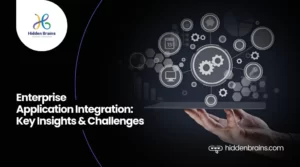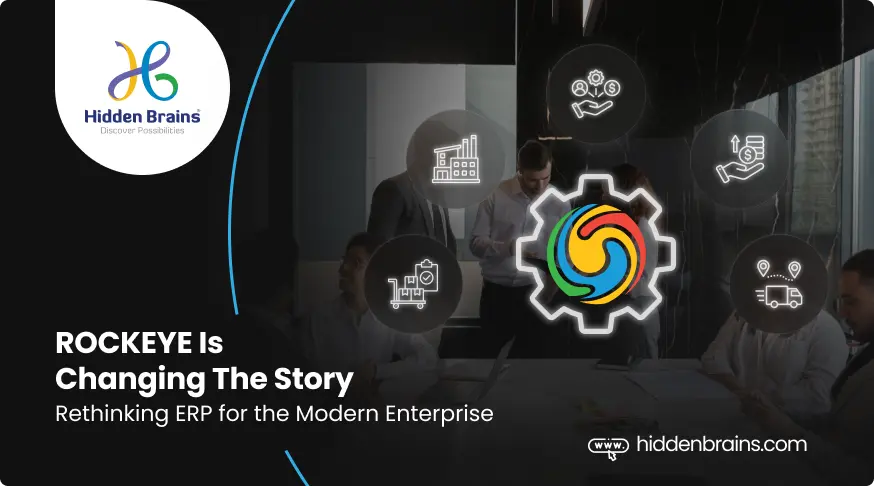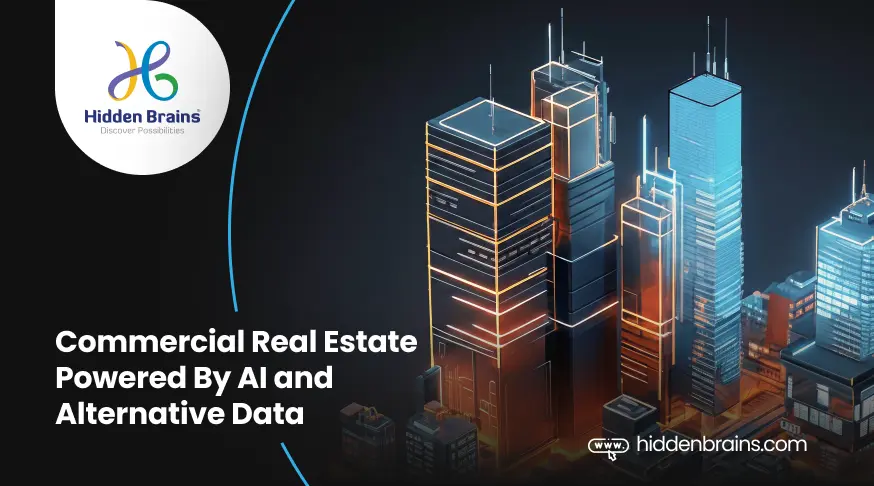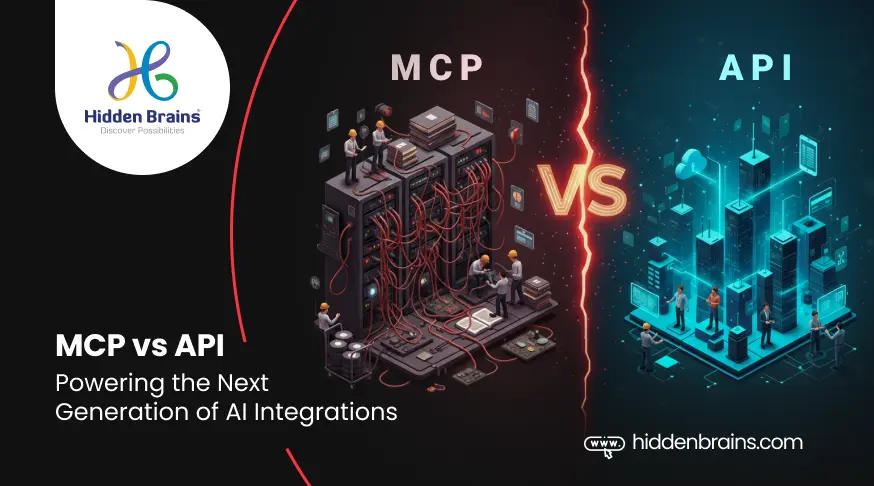Overview
Managing multiple disconnected apps slows business growth. That’s where Enterprise Application Integration (EAI) steps in. By connecting all your systems into one unified platform, EAI eliminates data silos, boosts real-time collaboration, and enhances decision-making. Learn how Hidden Brains’ next-gen RockEye ERP Solution empowers enterprises with seamless integration, automation, and smarter workflows to achieve operational excellence in 2024 and beyond.
Is Enterprise Application Integration (EAI) is still a new topic to you? Why has it become a new norm for organizations in 2024?
Enterprise Application Integration (EAI) is not a new hue. But the way it is simplifying the business process, EAI is surging in demand.
Enterprise Application Integration is a countinues practice of seamlessly connecting and integrating various software applications within an organization to make it all function as a unified system.
According to reports, the global application integration market is expected to grow from $15.4 billion in 2023 to $38.4 billion by 2028.
Businesses often use a diverse range of applications to streamline their operations, but by using EAI organizations can integrate the processing of their existing applications into one single system.
It allows for real-time data sharing, streamline business processes, and improve overall efficiency by eliminating data silos and facilitating hassle-free communication between different applications.
Does operating tasks through multiple applications slow down your business process? Hire a top software development company for Enterprise Application Integration (EAI).
If you are still confused about how exactly it works and empowering businesses, then its a worthy decision to take a look at the basics first…
Let’s watch the quick video to know “Enterprise Application Integration: A Quick Guide”
Enterprise Application Integration: A Quick Guide
What is Enterprise Application Integration (EAI)?
Enterprise Application Integration is a strategic approach of connecting various applications into one cohesive system.
Operating over a common platform, EAI consolidates data, resources, and processes, facilitating efficient workflows without major changes to databases or applications.
This integration enhances various processes, including billing, marketing, accounting, and customer relationship management, ensuring increased data availability and streamlined operations for improved business efficiency.
Before you hire a software developer to start integrating business processes into EAI, let’s take a practical look at the concept.
Overview of Enterprise Application Integration
Source: media.licdn
In today’s modern business era, organizations are relying on multiple applications like eProcurement, Warehouse Management Systems (WMS), Payroll Process Solutions, Employee Management Solutions (EMS), Multivendor Marketplace Portals (MMP), and more. The basic purpose of using these multiple applications is to streamline their business process.
But don’t you think that gathering and managing the data from different applications is a complicated and challenging task?
As a result, they may end up with a cluster of applications operating in silos, a lack of communication between teams, and inadequacy of data sharing.
To address this challenge, Hidden Brains introduced “ROCKEYE-ERP Solutions” which help enterprises integrate all applications in one place. The implementation of this intelligently crafted solution in enterprises resulted in a huge 70% cost reduction and ensured seamless data sharing.

Why Enterprise Application Integration is Important For Enterprises?
Modern digital architecture is complex and challenging to manage with multiple applications. That’s where Enterprise Application Integration takes place and allows businesses to share data and workflows seamlessly. By hiring an app developer, you can discuss your project needs with the experts and able to customize the solution.
But before that, let’s understand what value enterprise application integration adds to your business.
Understanding Enterprise Application Integration (EAI) Value to Your Business
Here are the reasons why modern businesses should look for Enterprise Application Integration now in 2024.
Data Integration: The major reason for Enterprise Application Integration into businesses is to bring uniformity in information across all enterprise applications. The cohesive system promotes real-time updates that are visible to all users.
Vendor Independence: A company doesn’t have to reimplement its business apps when dealing with different brands. Application integration enables seamless collaboration with different brand applications, serving as a unified interface for connected systems.
User Training Simplified: With a consistent interface, EAI eliminates the need for users to retrain when accessing applications and offers complete uniformity.
Removes Data Silos: EAI dismantles data silos, boosting seamless communication among diverse departments and systems. This ensures a unified view, empowering comprehensive business data analysis for informed decision-making.
Creates Process Efficiencies: Addressing inefficiencies in disparate systems, this solution automates data exchange, ensuring fast, smooth, and error-free operations in various business processes, and optimizing overall productivity.
Reduces IT Expenditure: Minimizing costs tied to maintaining standalone applications, it provides a unified framework utilizing existing infrastructure, optimizing systems efficiently without additional expenses.
Provides Real-time Data Access: Enabling seamless data exchange, this solution ensures real-time updates across integrated systems, supporting timely decision-making by instantly reflecting changes made in one application throughout the network.
Enhances Customer Experience: Integrating CRM, sales, and support systems, it ensures a consistent customer experience. Availability of current customer information across touch points leads to personalized experiences, fostering increased satisfaction and loyalty.
In a nutshell, in any business 85% of data is unstructured. Employing your team to structure the data in a perfect format will be a time and cost-draining process. Opt for hiring an app developer to automate workflows, boosting productivity by 0.8-1.4% annually.
Explore Hidden Brains, a leading software development company, for end-to-end process automation solutions and expert advice to boost business revenue.
So now you know the importance of using enterprise application integration in your business, but, what exactly you can automate or integrate with Enterprise Application Integration…
What are the Major Use Cases of Enterprise Application Integration?
When talking about Enterprise Application Integration (EAI), means various critical functionalities and processes across an organization can be seamlessly interconnected. This enhances overall operational efficiency and collaboration. But here are specific areas that can be integrated:
Customer Relationship Management (CRM) Solution
Wondering how Enterprise Application Integration can benefit your business with CRM integration? Let’s take a look:
- Get complete control and overview of customer interaction by integrating the CRM system with other in-house business applications.
- Ensure that customer data is consistently updated across sales, support, and marketing platforms.
- Enhance customer experience by providing personalized services based on integrated customer insights.
Supply Chain Management
Did you know the Supply chain is the biggest success-driving factor of any logistics business? This is why businesses prefer automating the supply chain process by implementing the Supply Chain Management solution. But why do you consider the Enterprise Application Integration?
- Connect supply chain, logistics, and inventory management systems to streamline the flow of information from product manufacturing to delivery.
- Enable real-time tracking of inventory levels, ensuring optimal stock management.
Here is a graph portraying the loss of business with poor supply chain management…

Order Processing
Struggling with manual ecommerce orders?
Modern solutions migrate to cloud-based order processes. Warehouse and inventory management solutions provide a 360-degree view, and Enterprise Application Integration enhances efficiency.
- Connect ecommerce, inventory, and CRM in one single system to get a deeper overview.
- Automate updates to stock availability when a customer places an order.
- Streamline the transfer of order details to the dispatch center.
- Provide customers with real-time notifications throughout the order fulfillment process.
Human Resources Management System and Payroll Management Solution
Centralized integration of the HRMS system simplifies workflows, minimizing manual input and ensuring data consistency between HR and payroll management systems.
Here’s why you should integrate HRMS and Payroll solutions with EAI:
- Integrate HR systems with payroll for automated application processing.
- Automate employee data updates, ensuring accuracy and efficiency in payroll processing.
- Provide a unified platform for managing employee information, benefits, and payroll.

Ecommerce Integration
Integration streamlines ecommerce operations, reducing errors and providing real-time updates across inventory and order processing. Apart, here’s why you should consider integrating the Ecommerce platform into EAI:
- Connect online storefronts with inventory and order processing systems.
- Automate updates to product availability and order fulfillment.
- Ensure a seamless and consistent experience for customers across various online channels.
Project Management
Integrated project management simplifies workflows, enhancing collaboration, and providing real-time insights into project finances and progress.
- Link human resource and project management systems.
- Centralize project scheduling, task assignments, and progress tracking.
- Include financial reporting modules to streamline project-related financial management.
- Simplify complex management architecture for more efficient project execution.
In essence, enterprise application integration allows the seamless connection of various systems, tools, and services across domains. This integration facilitates a unified ecosystem, promoting collaboration and agility within the organization.
Knowing all these facts and use cases of enterprise application integration technology, many businesses are curious to hire app developers to integrate their existing solutions with EAI. But what integration model should you choose for your business…
Understanding the Enterprise Application Integration Model
Though there are multiple models for application integration, which will be best suitable for your business?
Let’s understand it in detail…
1. Point-to-point Integration: Connects two data sources directly through a script, handling simple tasks like pulling and transferring information. this type of model is efficient for small operations but can get cumbersome when dealing with multiple systems simultaneously.

Source: thebrimichgroup
2. Hub-and-spoke Integration: Uses a central hub where applications connect through spokes. With this model, information is distributed from a central database eliminating direct subsystem connections. This practice ultimately minimizes the risk of errors and costly blunders. All it needs is components for automatic routing, simplifying development.
3. Bus Integration: An advanced hub-and-spoke model that operates autonomously. It follows predefined standards for data flow between applications, enabling efficient data transmission and retrieval based on service rules.
4. Middle-ware: Acts as a traffic router between applications, translating and supporting communication. Simplifies data aggregation across systems with different scripts and formats, ensuring seamless integration.
5. Micro-services: Adopts a standardized architecture for modern cloud-based applications. Facilitates data collection through web-based integration, utilizing APIs to acquire data from both internal and external sources.

Get started with the best choice of model!
Do you need an expert assistance?How do Hidden Brains be your trusted Enterprise Application Integration (EAI) partner? Let’s take a broad overview of the expert enterprise application integration services of Hidden Brains…
How Can Hidden Brains Help With Enterprise Application Integration Requirements?
Are you ready to build a better strategy for Enterprise Application Integration? Before you land in the market to hire an app developer you need to remember that any company’s success may depend on selecting the best EAI services.
To maintain the safety and effectiveness of operations and data, reliable and secure solutions are required. With successful enterprise application integration, businesses can access real-time data through the use of APIs, enabling them to decide more quickly and effectively.
This is where Hidden Brains’ Enterprise Application Integration services outshined and come forward to help you.
So how does Hidden Brains help you bring a change to your business?
Hidden Brains offers a “Next-Gen Business Transforming RockEye ERP Solution” that can help businesses create an interoperable platform and link different applications quickly and securely into one unified system. Our solutions are designed to enable businesses to scale and adapt to changing business requirements.
If you want to learn how our teams can help you connect your enterprise systems faster and eliminate data silos, book a free training session with our experts.
FAQs
If you are still wondering how enterprise application integration is useful to your business and why it has been gaining traction, then consider the FAQs section.
What Are the Perks of Using Enterprise Application Integration Services?
Enterprise application integration is a continuous process. It streamlines operations, automates workflows, and enhances communication for businesses. Let’s uncover the major benefits of enterprise application integration services:
– Automated Workflow
– Enhanced Communication
– Amplified Operational Efficiency
– Tap On New Business Opportunities
– Cost Optimization
What Industries Benefit Most From EAI?
Any industry can consider EAI to be beneficial. However, there are few major industries, particularly in finance, healthcare, retail, and manufacturing, where seamless integration and efficient data flow are critical.
Is EAI Suitable for Small Businesses?
Yes, EAI can be adapted by any size of business to streamline operations, automate workflows, and enhance communication, contributing to overall efficiency.
Can EAI Help in Cost Optimization?
Yes, EAI reduces IT infrastructure maintenance expenses by automating processes providing access to real-time market data, and optimizing overall costs.
How Does EAI Contribute to Tapping on New Business Opportunities?
EAI automates procedures, provides real-time market data, and accelerates decision-making, helping businesses stay agile and competitive.
Conclusion
Enterprise Application Integration (EAI) has become a powerful growth strategy for modern businesses, helping them overcome the challenges of managing multiple applications. By seamlessly connecting systems, automating workflows, and enabling real-time data sharing, EAI enhances efficiency and competitiveness. Hidden Brains empowers enterprises to unify apps, data, and cloud infrastructure into one cohesive system. Hire expert developers to streamline operations, boost agility, and achieve scalable success.
Contact us today!






























































































![Sales & Distribution [Oil & Gas] Sales & Distribution [Oil & Gas]](https://www.hiddenbrains.com/blog/wp-content/themes/blankslate/assets/images/sales_and_distribution-icon.74d08193.svg)

![Fluid Terminal Management [Oil & Gas] Fluid Terminal Management [Oil & Gas]](https://www.hiddenbrains.com/blog/wp-content/themes/blankslate/assets/images/fluid_terminal_management-icon.4b3a27a4.svg)































![Sales & Distribution [Oil & Gas] Sales & Distribution [Oil & Gas]](https://www.hiddenbrains.com/blog/wp-content/themes/blankslate/assets/images/sales_and_distribution-icon.74d08193.svg?1.0.0)
![Fluid Terminal Management [Oil & Gas] Fluid Terminal Management [Oil & Gas]](https://www.hiddenbrains.com/blog/wp-content/themes/blankslate/assets/images/fluid_terminal_management-icon.4b3a27a4.svg?1.0.0)
























































































































































































